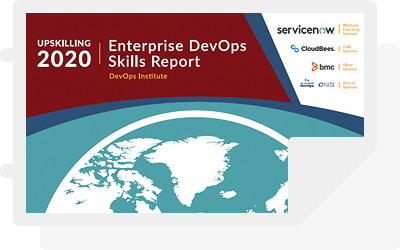As with previous years, DevOps is forecasted for healthy growth in 2019, with no slowing down in sight. In fact, IDC predicts the worldwide DevOps software market will reach $8 billion by 2022, up from $3.9 billion in 2017.
As is apparent from these numbers, DevOps is way more than just the buzzword it was 10 years ago, and if we have learned anything, it’s that DevOps has truly been worth every cent organizations have spent on investing in it. Bringing the worlds of development and IT operations together has not only helped businesses streamline their production, but it has also contributed to the creation of new and innovative tools that have emerged to support the movement, as well.
Looking ahead at this year, there are a few topics that continue to pop up again and again, proving they are the top DevOps trends of 2019. Let’s explore them.
AI and Machine Learning will transform DevOps
As with basically any industry, AI and ML are definitely the most talked-about trends when it comes to DevOps, and they have proven to be the perfect complement to the DevOps culture as a whole.
If DevOps’ overall goal is to unify and simplify development and operations, then AI and ML can be the ideal solution to some of the problems that have divided these disciplines in the past. Both of these technologies have the capabilities to process and organize high volumes of information quickly, reducing the need for IT staff to have to perform menial tasks and allowing them to complete more targeted work.
Applying machine learning to the software delivery lifecycle will have a big impact on DevOps, allowing organizations to analyze where bottlenecks, blockages, and capacity issues are occurring while also providing better understanding of where problems arise in continuous integration or continuous development. By making the DevOps pipeline smarter, AI-based predictive analytics will enable better anticipation of problems as well as ready-made solutions to fix them.
Another result of this trend will be the enhanced collaboration between application developers and data scientists. According to Gartner, by the year 2022 at least 40% of new development projects will have AI co-developers on their team. This partnership is crucial for organizations to be more efficient in delivering new functionalities that customers want while continuing to streamline the delivery and testing process.
DevSecOps will become a major priority
Along with the idea of making a smarter pipeline, enterprises are quickly accepting the fact that security and compliance must be seamlessly integrated into DevOps transformations if they are to be successful. To do this, teams are focusing more energy on DevSecOps.
Unlike traditional security measures that are typically added on at the end of the development pipeline, DevSecOps is the process of thinking about application and infrastructure security from the start. This “Shift-Left” mindset in DevOps means that instead of thinking of security as a perimeter, it needs to be injected into every layer as secure code.
With this, we should see development and security teams also working closely together across multiple points in DevOps workflows, not only to ensure it is secure but to preserve the ideal agility and speed of DevOps, as well. This collaboration will help organizations take advantage of tools and platforms to embed security policies into automated environments, allowing vulnerabilities to be quickly detected and mitigated.
Attention on automation will continue
In DevOps, there is a lot of focus on automation, with the main goal of essentially continuous application updates. To have the best chance at achieving this, it is necessary to understand and remember the 6 C’s of the DevOps cycle:
- Continuous business planning
- Collaborative development
- Continuous testing
- Continuous release and deployment
- Continuous monitoring
- Collaborative customer feedback and optimization
By keeping emphasis on these six pillars, it helps to ensure that automation applies between each stage, getting closer to zero-touch automation.
For companies that haven’t fully adopted this, 2019 will be the year to jump on the bandwagon. Whether it’s utilizing machines to speed up the pipeline, providing faster customer service with chatbots, or even just streamlining inventory management with a tracking system, automation will be key.
Focus will shift from CI pipelines to DevOps assembly lines
Pipelines are the visual representation of your application from source control all the way through to production. Continuous Integration (CI), on the other hand, is the practice in which developers will check their code into a version-controlled repository several times per day. Automated build pipelines are triggered by these check ins which allow for fast error detection.
CI consists of three phases: build, test, and push. This approach, however, is extremely developer-focused and requires manual integrations multiple times a day. While most organizations use tools for automating these tasks, the DevOps tool chain is extremely fragmented and piecing it together to achieve continuous delivery starts to get complicated.
This is where DevOps assembly lines come in. DevOps assembly lines are focused on bridging the gap between both automated and manual tasks, streamlining application production while eliminating redundancies. They automate and connect activities performed by different teams, such as CI for devs, security patching for SecOps, infrastructure provisioning and configuration management for ops, etc.
Assembly lines are piquing interest in 2019 as they focus on gluing together the various DevOps activities into distinct, event-driven workflows with the capabilities to easily share information across both activities and teams.
Microservice adoption will increase
In the past few years, microservices and DevOps have started to almost go hand-in-hand. Microservices are a specific method of designing software systems that structures an application as a collection of loosely coupled services. These are independent entities and they don’t create any dependencies on other systems if something should go wrong.
Microservice architecture fits well into DevOps as it reinforces the idea of breaking large applications down into smaller pieces, allowing teams to tackle problems as they come. These independent pieces are perfect for continuous delivery pipelines as they can be released as they are ready, maintaining the steady flow of deployments.
Using containers for the delivery of these applications will also continue to increase this year, with forecasts predicting that the application container segment will scale to $4.3 billion by 2022. Around the world, many CIOs have already adopted container technologies like Kubernetes, which will play a big role in the growth of containers across the industry.
DevOps in the coming years
Overall, it’s an extremely exciting time to be involved in the world of DevOps and 2019 is sure to see some big changes. As for the years to come, the energetic pace is unlikely to slow down anytime soon, making this as good a time as any for companies to adopt these DevOps trends if they haven’t already.







